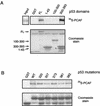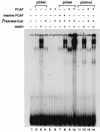p53 sites acetylated in vitro by PCAF and p300 are acetylated in vivo in response to DNA damage
- PMID: 9891054
- PMCID: PMC116049
- DOI: 10.1128/MCB.19.2.1202
p53 sites acetylated in vitro by PCAF and p300 are acetylated in vivo in response to DNA damage
Abstract
The p53 tumor suppressor protein is a sequence-specific transcription factor that modulates the response of cells to DNA damage. Recent studies suggest that full transcriptional activity of p53 requires the coactivators CREB binding protein (CBP)/p300 and PCAF. These coactivators interact with each other, and both possess intrinsic histone acetyltransferase activity. Furthermore, p300 acetylates p53 to activate its sequence-specific DNA binding activity in vitro. In this study, we demonstrate that PCAF also acetylates p53 in vitro at a lysine residue distinct from that acetylated by p300 and thereby increases p53's ability to bind to its cognate DNA site. We have generated antibodies to acetylated p53 peptides at either of the two lysine residues that are targeted by PCAF or p300 and have demonstrated that these antibodies are highly specific for both acetylation and the particular site. Using these antibodies, we detect acetylation of these sites in vivo, and interestingly, acetylation at both sites increases in response to DNA-damaging agents. These data indicate that site-specific acetylation of p53 increases under physiological conditions that activate p53 and identify CBP/p300 and PCAF as the probable enzymes that modify p53 in vivo.
Figures







References
-
- Anderson, C. Personal communication.
-
- Arany Z, Sellers W R, Livingston D M, Eckner R. E1A-associated p300 and CREB-associated CBP belong to a conserved family of coactivators. Cell. 1994;77:799–800. - PubMed
-
- Arias J, Alberts A S, Brindle P, Claret F X, Smeal T, Karin M, Feramisco J, Montminy M. Activation of cAMP and mitogen responsive genes relies on a common nuclear factor. Nature. 1994;370:226–229. - PubMed
-
- Avantaggiati M L, Ogryzko V, Gardner K, Giordano A, Levine A S, Kelly K. Recruitment of p300/CBP in p53-dependent signal pathways. Cell. 1997;89:1175–1184. - PubMed
-
- Bannister A, Kouzarides T. The CBP co-activator is a histone acetyltransferase. Nature. 1996;384:641–643. - PubMed
Publication types
MeSH terms
Substances
LinkOut - more resources
Full Text Sources
Other Literature Sources
Molecular Biology Databases
Research Materials
Miscellaneous
